#support Black creatives making art that centers Black people
Text


On May Day 2017, anarchists participated in lively demonstrations all around the United States, from the heartland to the coasts. In the Northwest, Seattle witnessed a successful block party at the site of a juvenile corrections center, while in Olympia anarchists barricaded train tracks to oppose fracking and clashed with police. Support arrestees here. Yet Portland, Oregon may take the cake for the most creative and combative May Day. Demonstrators not only defended themselves from unprovoked attacks from police who declared the march a riot—they also introduced exciting new innovations into the aesthetic of the black bloc street presence. Here, comrades from Portland explain their goals with the giant spiders they created for May Day, and offer a helpful guide for those who wish to make spiders of their own.
In an effort to bridge the gap between art and activism, giant spiders were assembled off-site and pushed up the street to the demonstration, stocked with water bottles, snacks, earplugs, and other party favors. The idea was to narrow the divide between “us” and “them” that often exists at demonstrations, and it was a complete success. We performed community outreach, engaged in cultural development, boosted morale, provided crucial supplies, and created an amazing photo opportunity in the process.
The concept is multi-dimensional: it works on many different levels. The idea began from frustrations around attendance at local demonstrations. In Portland, where the majority of citizens seem to be white, middle-class, and apolitical on account of these privileges, they don’t show up unless a demonstration concerns their interests specifically. However, Portlanders are fascinated by their own love of art and “wacky” stuff as well as the commodification of protest as “funtertainment.” We decided to embrace this love of the “weird” to test whether a hyper-localized approach to engaging people could succeed.
Our tactical art enabled us to fill a supporting role for other participants in the march, helping challenge narratives that the black bloc is an “othered” or “othering” tactic. Whether this separation is intentional or not, the fact remains that the general public is often hesitant to engage with us. Bearing that in mind—as well the tendency of the Portland Police Department to brutally shut down demonstrations—we stocked our Spiders with fliers, water, LAW (liquid, antacid, water, the eyewash with which street medics treat pepper spray), ear plugs, and snacks. We also included a few other party favors, because anarchy needs revelry!
We intentionally engaged with the folks around us. A lot of people walked up to ask what the spiders meant! It was inspiring to see so much dialogue between folks in everyday garb and folks in black bloc. We explained the ideas behind our actions as anarchists and the creations themselves: the three spiders representing Mutual Aid, Solidarity, and Direct Action.
A word about symbolism. The idea of using the spider as an icon of resistance is that spiders are always there watching, waiting, and keeping the environment free of pesky insects and other parasites that consume resources without supporting their fellow beings. While we may look scary, we’re here with you and for you. We are the spiders, and the insects are the societal ills that we fight against.
The symbolism of the black widow spider is rich with history that guides our work. We want to contribute to that rich history, adding our own interpretations. Mutual Aid, Solidarity, Direct Action are our black widow’s cruses. (Crux? Curse? Cures?)
In regards to developing our own culture, there are many barriers we face in this process. State repression is the biggest threat, of course. The specter of state repression can complicate organizing, planning, and building trust in our communities. Portland has a history of repression and slander, ruining the lives of activists and anarchists; these horror stories reverberate throughout the underground. We can’t allow ourselves to be publicly disparaged and forced into hiding by our adversaries and their culture war, so we create as a political act. Creating is intuitively human: we plan, we build, we think, we conspire, we imagine. It is also an activity in which everyone can engage to some degree while building new skills. It enables us to get to know each other, build trust, and share time and company.
More globally, seizing the Spectacle is a step towards our goals, because it allows us to dictate our own narratives. With the development of Public Relations and Social Engineering, the visage of capitalism has come to define its delusional reality. To paraphrase Guy Debord, lived experiences are now taken in as a collection of representational images. We can tell our own stories and show the general public what these three principles mean in action. We can create our own mythos, speaking out on our own terms, in our own language, with our own symbols. The state and media dictate too much of what we’re allowed to say and how it’s spun—it’s time to spin our own webs to connect and fortify our relationships.
We are building the bridges we need to move forward. The existing connections between art, activism, and anarchism are fiery and well-storied. The new wave of repression under Trump’s regime is still building steam, but it is already proving dangerous. We need to be more careful than ever. Art allows us to demonstrate and show our fangs, and we can use art to empower those around us.
#how-to#guides#and manuals#May Day#Portland#protest#reportback#community building#practical anarchism#anarchist society#practical#mutual aid#grassroots#organization#anarchism#resistance#autonomy#revolution#anarchy#daily posts#communism#anti capitalist#anti capitalism#late stage capitalism#grass roots#anarchists#libraries#leftism#social issues#economics
26 notes
·
View notes
Text

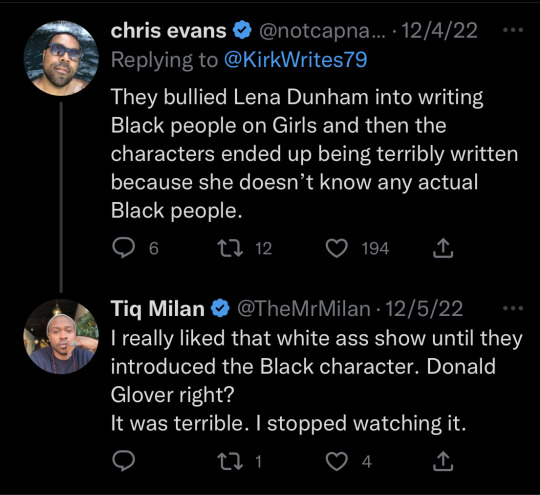
A million times, THIS 👆🏾👆🏾👆🏾
#I am the first person to champion seeing Black characters on screen in a wide variety of different worlds and experiences#but I can’t get behind begging white creatives to give that to us#time and time and time and time again has shown that they cannot be trusted#that theyre not willing to do the work#that theyre not willing to change#if they do it’s temporary#all the diversity and inclusion hires that came out of the 2020 protests have been rolled back#Netflix laid off a bunch of their POC staff#creative and diverse shows are being cancelled left and right#on Netflix and platforms like HBO#support Black creatives making art that centers Black people#creating stories with nuance and dignity for their characters#anything else is for the birds
5 notes
·
View notes
Text
watched 'across the spiderverse' yesterday and it really stood out to me how, in the midst of all the explosions and web-slinging and Deep Family Talks™, 'across the spiderverse' has a lot to say about white supremacy. it stands out to me that when miles needs his allies the most, he's abandoned by gwen and peter (his two closest friends from the first film)—not because they don't love him, because they say they do, but because their love doesn't extend past the reaches of the system set in place and miles' place in that perceived system. they're full of "oooh don't be maaad at me" and "this is for the best!" as miles is running for his life. as miles is insisting that his dad shouldn't have to die to maintain some stupid fucking system. peter and gwen, instead of putting miles first or prioritizing their love for him, instantly justify and let go of him when his existence challenges a framework they are comfortable in and already supported by.
meanwhile, miles' real sources of support are hobie (a black anarchist who very loudly protests the system) and margo kess (a black VR gamer). when he needs to escape, they're the ones who actively help him out. even jessica drew, i think, kind of helps—it seems at the end she's ambivalent about really chasing miles down, and you can see throughout the film she's tussling with her thoughts on the spider society, pushing its boundaries here and there.
and getting back to gwen—yeah, we can see that she is struggling with problems of her own the whole movie. she's insecure, she's unmoored, the spider society is something that makes her feel safe. but the movie doesn't let her problems soften or apologize for her betrayal of miles. she's wrong. she is wrong. the movie doesn't deny it, not for a second, and the narrative never uses her issues to justify what she is foisting on miles.
i'd be really curious to know how much of this was discussed by the creative team—because from the outside, it looks like they planned a film centered on the black lives matter movement, with a story about challenging oppressive systems and valuing black solidarity, with a sidebar discussion on white supremacy, and then just....made it. actually made a movie about black people surviving a system that doesn't recognize them as human. and did it with superheroes and pop art and a segment made entirely out of Lego. and then got everybody to watch it! like! what!!
i'd be curious to see if this stood out to anyone else, and especially to hear black fans' thoughts and analysis. i did a quick sweep through the tag (man y'all are horny for miguel), but i'm sending this post out there hoping other people might have thoughts they want to share too.
anyway great movie 10/10
#spiderman across the spider verse spoilers#miles morales#spider verse#across the spiderverse#spiderman atsv#disclaimer: i am white so i may definitely be missing some nuances here#would like to hear other people's thoughts!#tw racism#tw white supremacy
74 notes
·
View notes
Text
Kamikita; Land of Patience and Glory
south west corner of the continent, primarily human citizens
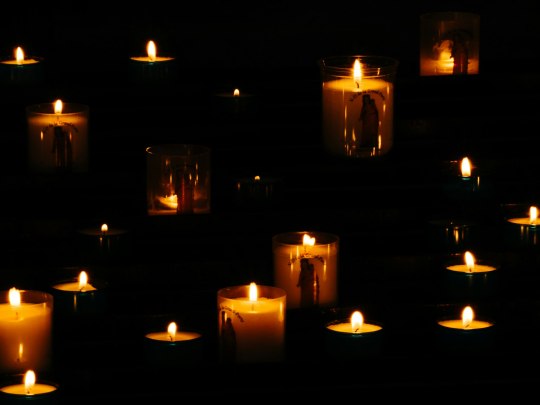
Matt Seymour on Unsplash.
Society:
The social structure mostly mimics the classes of England in the late middle ages. Kamikita call themselves gracious or foolhardy, but outsiders often call them compassionate people, or arrogant bastards. This could be because travelers and immigrants are greeted kindly with the expectation that they will be leaving, and if not they are encroaching on humans lives. Ironically, humans are happy to settle anywhere in Klenith.
Subtle or easily hidden tattoos are fine, magical or otherwise, and few subtle piercings are also acceptable. Makeup, jewelry and perfume are fun and creative ways to decorate yourself, hats and umbrellas are trending in Kamikita recently. Typically, an attractive human will not use any artificial things to make themselves more beautiful. Long hair and a good sense of humour are desired.
If the disabled cannot be supported by their families, they can be helped at the centers run by religious followers. The buildings are made for anyone that cannot support themself and can be found in any major city in Kamikita. In smaller towns, the religious sites may take these people in but may also send caravans to larger cities when resources are stretched thin.
Professions:
Education in Kamikita is generally privatised, those able to pay will send their children to learn in certain guilds in major cities, otherwise families teach their own in the family business. This means there are no schools, the closest being following an 'instructor' while being inducted into a guild.
Art is celebrated in Kamikita, especially in festivals and ceremonies of all kinds. Song and dance are the most popular forms, anything musical can bring people together.
Language:
The 4 main languages in Klenith are human, orcish, dwarvish, and elvish. In Kamikita, their main language is human with use of all other languages within their merchant guilds and/or along their borders. Human has no discernible accent. Their writing however is very fun, loopy, and letters flowing together*.
There is the royals sign language, and general peoples sign language which started in the merchant guilds and quickly grew to be popularly used throughout Klenith. It is commonly referred to as the merchants hand signs but because of its use everywhere and outside the guilds as well, it is very much the general language overall.
Kamikita has fairly even swears from vulgarity and religious words. Humans like to mix and match swears from other countries, finding the most obtuse way to insult someone. As for gestures, the middle finger is common, and pulling at your bottom eyelid.
The royal family bare a green crest with a yellow four pointed star, held at the top between two black hands. The royal colours are yellow and green. The star has four points, representing the four major roads out of the capital city, Maashi, and the hands holding the 'city' aloft are the people in Kamikita.
*like cursive english
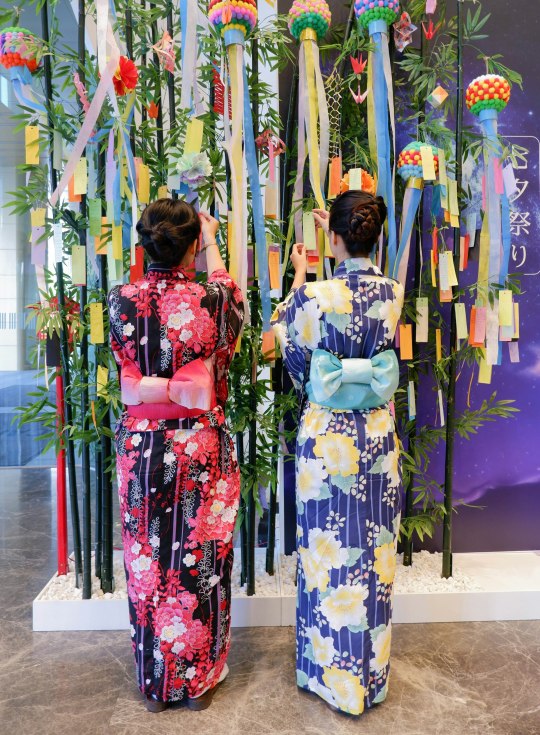
janedvn on Unsplash.
Other Parts:
For Great Kettering. 1 / 2 / 3 / 4
For Solistal. 1 / 2 / 3 / 4
For Kamikita. 1 / 2 / 3 / 4
For Birkina. 1 / 2 / 3 / 4
#ted talks#the klenith saga#tws#my writing#my worldbuiding#worldbuilding#settings#kamikita#maashi#humans#patience and glory#society#professions#languages#links#unsplash#undescribed image#fantasy#high fantasy#part 3#part 3 of 4
2 notes
·
View notes
Text

heyo!! I’m erica joy :) please use she/they pronouns. I have no preference, but I appreciate when my pronouns are interchanged.
I am a taurus sun with an aries rising and aries moon.
I am a fat, Black queer person who’s really just out here tryna learn who I am, especially as a bb aries rising. As a recent Bachelor’s of Social Work grad (c/o ‘21) who found (way too much?) identity through leadership roles on my college campus, astrology and tarot have been ways to figure out who I am outside of being a good leader.
In true Taurus fashion, I am determined to prioritize rest and bask what makes me happy. Right now, that looks like reading cute comics, making semi-elaborate meals, watercoloring bright blobs, learning Brazilian Portuguese, and watching The Real Housewives.
I organize community spaces for the CH Fam. Cosmic Healing is a community endeavor, and as such, there needs to be opportunities to meet and support one another. I plan + lead group conversations, mindfulness sessions, and an upcoming newsletter. I’m also sometimes the person you’ll hear from before and after sessions with kay, ensuring that you understand the different session options, confirming appointment times, and supporting in all ways I can.
MY FACILITATION STYLE + VALUES
I love working with people one-on-one, but seeing people connect and bond is so fulfilling! Co-creating a space! Planning activities! I have been facilitating group discussions for over 7 years, beginning my journey as president of French club (lol). While attending Seattle University c/o ‘21, I continued leading conversations as a team leader for my university’s Center for Community Engagement, a group leader for orientation and new student retreat, co-president of our gender justice center, and as president of our QTPOC club. In my final year of my Social Work program, I took a course dedicated to group work while also co-facilitating a creative arts group at a community mental health organization.
Whether 3 or 10 or 50—group work has the capacity to form relationships, expand perspectives, and lead to change. I have a pretty adaptive facilitating style being that I’m an earth sun, fire rising + moon, and water venus; I can keep the conversation grounded, hype the group up, and create space for all the feels. That being said, I tend to lean towards semi-structured and directed group planning, allowing for space to have the session to be altered in real time. I practice from the mindset that while I have the title of facilitator, everyone involved in the group helps to create the dynamic. Please ask your fellow group members questions and share your reactions. I acknowledge (and love!) that each group has different goals and energies that impact the dynamic and needs of the time we spend together. I like to bring different activities and ways of reflecting into the group, this could look like participants bringing in a song to share with the group or doing a quick art activity or maybe even doing a show-and-tell.
I lead with a pro- fat, Black, and queer lens. I reject white supremacy and the values that have seeped into our society. I believe we as people all have the capacity to cause harm, and we need to be held accountable when those mistakes are made. In groups, it is not uncommon for uncomfortable situations to come up. As the facilitator, I understand that I have a responsibility to mediate. We each have different thresholds and experience the same actions/words differently, so it is also necessary for members to let me know when harm has occurred. I am currently educating myself on the Transformative Justice process, so I can approach any situations to the best of my ability.
In my social work program, I learned that because spaces were client-centered, I could not share about myself and my experiences, BUT with Cosmic Healing Family—we are indeed FAMILY, so for our groups, please know that I will also be processing, healing, and growing with you.
If you’re interested in being a part of a future community group complete this short interest form
if you’re interested in getting a personal reading with kay, fill out this form
Continue learning about us and our thoughts on Reciprocity and Reparations
#astrology#black astrology#black astro community#cosmic healing#healing journey#aries#taurus#gemini#cancer#leo#virgo#libra#scorpio#sagittarius#aquarius#pisces
2 notes
·
View notes
Video
vimeo
Celebrate 10 Years Stitchers Style! from Saint Louis Story Stitchers on Vimeo.
Compilation video of end of year videos of Saint Louis Story Stitchers as we look forward to celebrating our first 10 years!
SAVE THE DATE!
10 Year Anniversary Celebration!
August 9 and 10, 2024
Our History -
Once upon a time there was a stitcher who liked to embroider stories from the newspaper. One day she was stitching about two sisters who were shot on their porch in University City. One sister died. Two brothers were arrested for the crime. The stitcher reflected on the power of stitching throughout history; of the Aids quilt and quilts on the Underground Railroad. She determined to join with others to create change. In August 2013 eight artists gathered in Old North St. Louis and founded the Saint Louis Story Stitchers Artists Collective — to make change. On December 24, 2014, Saint Louis Story Stitchers was incorporated as a charitable organization in the Great State of Missouri.
Since that time, we have made great strides, working with people to stop the violence and to empower youth to make a change for Saint Louis through creative youth development.
Accomplishments by the numbers since 2014 include —
8 founding artists
800 teens and young adults have participated in free programs
179 artist mentors
37 board members
185 public performances to 62,000 live audience members
30 songs written
2 books, 1 game, and 1 portfolio published
3 plays written and produced
15,000 hours open for youth
4 studios including The Center
30 Saint Louis neighborhoods visited
153 podcasts published
Revenue growth from $59,324 in 2015 to $701,593 in 2023
In 10 years, with your help, we have brought $792,795 national dollars home to STL to support young artists and artists of color in building bridges to peace for all. National awards include 3 grants from the National Endowment for the Arts totaling $70,000, a 2021 Accelerator Award for $500,000 from The Lewis Prize for Music, $73,611 from the CDC Foundation, $25,000 from the Obama Foundation, and $30,000 from The Charity Pot.
Over 10 years, Story Stitchers have collaborated with artists 16 to 83 years old on music, storytelling, neighborhood block parties performances, public service announcement campaigns, and multi-year signature projects focusing efforts on high quality art and innovative youth violence prevention programs. Artists have built an archive of Black voices from 2014, through Ferguson and Michael Brown's death, the Covid-19 pandemic, George Floyd, and through years of heartbreaking violence in our beautiful city to bring unheard voices to light.
Together, with you, we are reshaping the future of our region through youth empowerment that builds from exposure and experiences in high quality artistic practice.
So let's celebrate!!
Here are the details of the event:
10 Year Anniversary Celebration
.ZACK Theatre
3224 Locust, St. Louis 63103
August 9, 2024
11:00-3:00 Youth Empowerment Summit
In memory of Michael Brown
Free to 50 youth with boxed lunches
August 10, 2024
7:00 VIP Reception with hor d'oeuvres, wine, beer, soda
8:00 Hall of Fame Awards from Stitchers Youth Council
9:00-11:00 10 Year Anniversary Album Release Party & Concert
Featuring Story Stitchers artists from across the 10 years!
Tickets coming soon on MetroTix!
Follow our e-news at storystitchers.org to stay tuned!
0 notes
Text

Artistic ways to mark Black History Month in Central Florida
By MATTHEW J. PALM | [email protected] | Orlando Sentinel
PUBLISHED: February 8, 2024 at 5:00 a.m. | UPDATED: February 9, 2024 at 3:22 p.m.
Loading your audio article
As the nation observes Black History Month, there are plenty of ways in Central Florida to mark the occasion artistically. The following plays, concerts and art exhibitions below shine a light on Black history, celebrate Black heritage or give voice to contemporary Black artists in writing, painting and musical composition.
The arts always provide food for thought; these offerings allow for reflection and celebration along with entertainment.
Theater
Playwrights’ Round Table, for the third year, presents its Black History Month Showcase. Six short plays by Black writers are included in the production, which runs Feb. 9-18 at Imagine Performing Arts Center in Oviedo Mall (tickets are $12-$20 at ImaginePerformingArtsCenter.org).
In Marcus Scott’s “Call and Response,” a young man is confronted after falsely sending emergency responders to someone as a joke, a practice called “swatting.” Michael Hagins contributed two works: the dark comedy “Man Bites Dog” and “First Date,” which is humorously described as “Making a connection can be hard, especially if your kids are assaulting Chuck E. Cheese.”Thao Tran and Chuck Roberson perform a scene from “Technical Support” by Amaris Gagnon, part of Playwrights’ Round Table’s Black History Month Showcase. (Courtesy Daniel Cooksley via Playwrights’ Round Table)
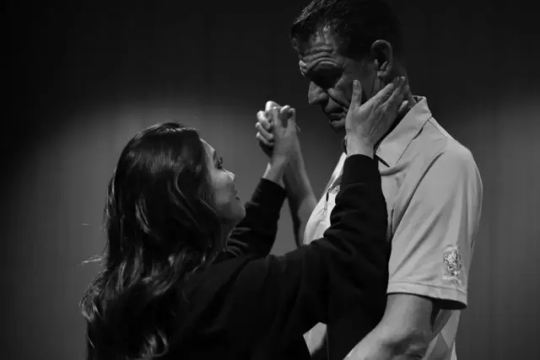
Amaris Gagnon also wrote two of the plays. “Mother of the Apocalypse” looks at a nurse at a fake abortion clinic, and “Technical Support” asks where lonely people come from.
Finally, in Krystle Dellihue’s “White Coat,” a young man on the cusp of achieving his dreams suddenly has to make a very difficult decision with his girlfriend. The cast of “A Raisin in the Sun” at Rollins College prepares for the production with a West African movement and traditions workshop from Julie Coleman.
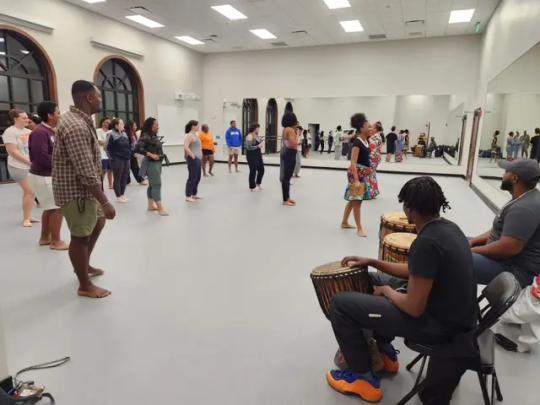
(Courtesy Rollins College) Rollins College in Winter Park presents a classic title with “A Raisin in the Sun” taking the stage at the Annie Russell Theatre Feb. 16-24 ($20, rollins.edu/annie). Lorraine Hansberry’s 1959 masterpiece follows a multigenerational Black family as it navigates prejudice. Felichia Chivaughn directs.
Turning to African heritage, the MAC Boys tackle “Ruined,” Lynn Nottage’s Pulitzer Prize-winning play set during civil war in the Democratic Republic of Congo, where strong Mama Nadi owns a bar that draws characters from different sides of the conflict. The play will be performed at Orlando Family Stage, where the MAC Boys spotlight stories and works of and by people of color. It runs Feb. 22-25 with tickets ($20) at OrlandoFamilyStage.com.Julian Brown plays the djembe, an African drum, in Orlando Family Stage’s “Giraffes Can’t Dance.” (Courtesy Michael Cairns via Orlando Family Stage)
Also at Orlando Family Stage is the theater’s own production of “Giraffes Can’t Dance” for youngsters and their families. Based on the children’s book by Giles Andreae, the show is set on the African savannah and features a look at African musical heritage. Julian Brown plays the show’s djembe drummer; the djembe is a goblet-style drum originally from West Africa.
The show itself, adapted by Black playwright Gloria Bond Cunie, is a sweet look at feeling different and friendship as African animals prepare for a big dance. Director Ke’Lee Pernell leads the creative team for “Giraffes Can’t Dance,” which runs through Feb. 25. Get tickets ($15 and up) at OrlandoFamilyStage.com — and check out the theater’s ongoing salute to Black playwrights at Facebook.com/OrlandoFamilyStage.

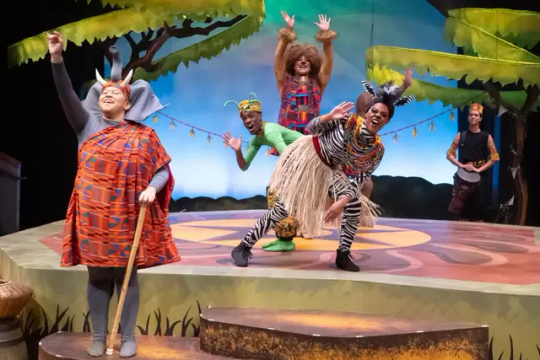
Joy Allen, from left, Adourin Jamelle Owens, Jordan Sophia, Dayla Carroll and Julian Brown star in “Giraffes Can’t Dance” at Orlando Family Stage. (Courtesy Michael Cairns via Orlando Family Stage)
Music
The Sanford Jazz Ensemble salutes Black musicians in its Black History Month Concert at 3 p.m. Feb. 11 at the Ritz Theater in Sanford. Featured singer Ron Stark will perform Motown songs by Marvin Gaye, Smokey Robinson, The Four Tops and The Temptations, while the band will play songs by Michael Jackson, Grover Washington, Earth Wind & Fire and Tower of Power. Tickets ($27.50) are available at ritztheatersanford.com.
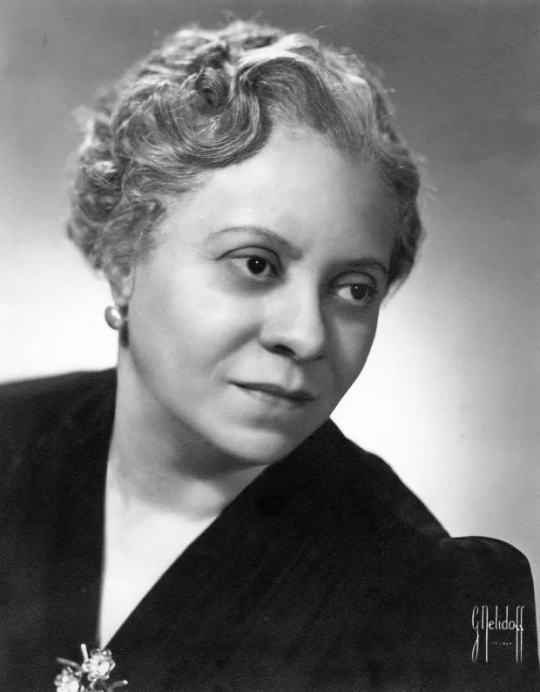
The 89th Bach Festival will acknowledge a significant moment in Black artistic history when its orchestra performs Florence Price’s Symphony No. 1 in E minor as part of its “Sanctuary Road” program Feb. 17-18 (tickets $15 and up; bachfestivalflorida.org). When the Chicago Symphony Orchestra played the work in 1933, it was the first time a symphony composed by an African American woman was performed by a major American orchestra.Composer and musician Florence Price, photographed by G. Nelidoff in Chicago, Illinois. (Courtesy University of Arkansas Libraries)
As for “Sanctuary Road,” it highlights a grimmer era of Black history. That work by composer Paul Moravec and librettist Mark Campbell sets the stories of enslaved Americans to music. It’s based on William Still’s 1872 book of slave narratives, “The Underground Railroad.”
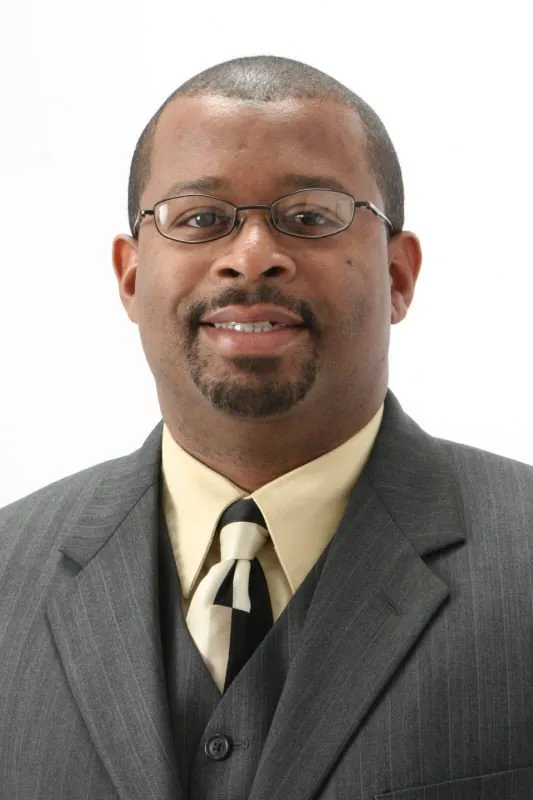
Composer James Lee III was inspired by a more modern moment in Black history, the Rev. Martin Luther King’s “I Have a Dream Speech.” His “Shades of Unbroken Dreams,” written 60 years after King’s famed 1963 speech, is part of the Orlando Philharmonic Orchestra’s “Brahms Third Symphony” program Feb. 24-25.Composer James Lee III was inspired by Martin Luther King’s “I Have a Dream Speech.” (Orlando Sentinel file photo)
“Shades of Unbroken Dreams,” co-commissioned by the Philharmonic, is making its Florida premiere in the Steinmetz Hall performance (tickets: $20 and up at drphillipscenter.org). Composer Lee even matched the cadence of King’s speech in parts of the music.
“For me, this ‘I Have a Dream’ speech and this concerto is really a vehicle through the arts that can really stimulate one to think about what is their role?” Lee told the BBC about the work. “How can they participate in helping to achieve this dream 60 years later?”
Timucua Arts Foundation will present “Timucua Amplifies Black Voices,” a weekend of music and spoken word, Feb. 16-18 at its venue, 2000 S. Summerlin Ave. in Orlando. Performers include Solomon Jaye, Britton Rene Collins, Brandon Martin, the Jarred Armstrong Trio and the DeAndre Lettsome Quartet.
Jaye is a vocalist and high-energy tap dancer, while Collins combines pantomime, poetry, gesture and improvisation in theatrical percussion performance. Martin will present a vocal recital, “Voices of Justice.”
Get more information on the individual performances and tickets at timucua.com/events/tag/black-history-month.
Art
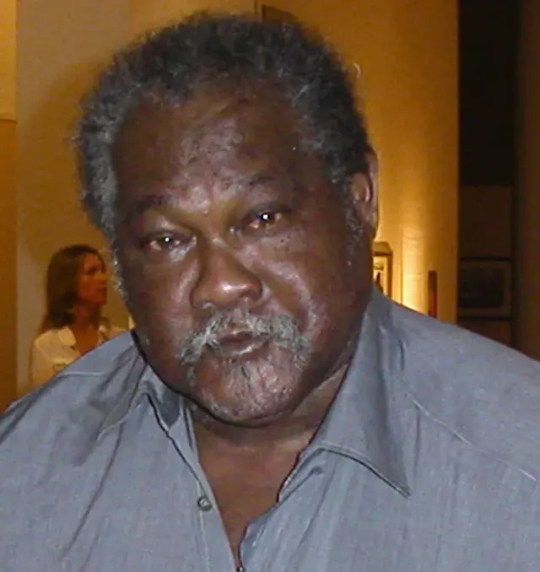
Orlando City Hall’s Terrace Gallery will host a Black History Month art exhibition through March 31, featuring works by African Americans. From 10-11:30 a.m. Feb. 12 the public is invited to meet some of the artists. Regular gallery hours are 8 a.m.-9 p.m. weekdays, noon-5 p.m. Saturdays and Sundays. The gallery is on the first floor of city hall, 400 S. Orange Ave. and admission is free, 12-5 p.m. Saturday and Sunday.Purvis Young is among the artists on view at the Mennello Museum of American Art in Orlando. (Orlando Sentinel file photo courtesy of Skot Foreman)
And finally, the city’s Mennello Museum of American Art is currently exhibiting “Self-Taught Black Artists in the American South.” Thirteen artists are featured in the exhibition, which highlights examples from the Mennello’s permanent collection alongside works from a 2023 acquisition from the Polk Museum of Art. Artists represented in paintings and sculpture include Mary Proctor, Alyne Harris, Purvis Young, Jesse Aaron and Mose Toliver.
The Mennello Museum, at 900 E. Princeton St. in Orlando, is open 10:30 a.m.-4:30 p.m. Tuesdays-Saturdays, noon-4:30 p.m. Sundays. Admission is $5 or less. Get more information at mennellomuseum.org.
Follow me at facebook.com/matthew.j.palm or email me at [email protected]. Find more entertainment news at OrlandoSentinel.com/entertainment

#marcus scott#marcusscott#write marcus#writemarcus#black playwrights#theatre#theater#playwrights#playwright#black theatre#call and response
0 notes
Text
February's Theme is NATIVE!

February's Theme is NATIVE.
Our global theme for February is NATIVE. It was chosen by our Honolulu chapter and illustrated by Jack Soren.
Where you are from shapes who you are. Where you call home influences your worldview. Understanding the traditions of your ancestors can help answer the question, “where do I belong?” Your connections to a place and the past should rightfully be a source of great pride.
The unique customs, art, and languages of native cultures make the tapestry of human civilization more vibrant. Yet many indigenous communities have faced marginalization, land dispossession, and cultural erasure. How much have we lost and what can be preserved?
By respecting and celebrating the traditions and achievements of native people everywhere, we can discover a deeper sense of connection and unity. What does our history have to teach us? What can we learn from each other?

This month we're invited to commune at Coffee Makes You Black, a mission-led community hub in Milwaukee's Lindsay Heights neighborhood. Rooted in uplifting and empowering the local Black community, CMYB serves as a social, political, and economic resource center fueled by southern comfort inspired cuisine.
Set your alarms — registration opens next Monday!
Event Details
Date: Friday, February 16th
Time: 8:30 – 10:00am CST
Location: Coffee Makes You Black - 2803 N. Teutonia Ave, Milwaukee, WI 53206

What better way to get inspired by this month's NATIVE theme than to listen to music by local Milwaukeans?! This month's playlist includes bops from the likes of Grace Weber, Buffalo Nichols, Bryan Cherry, Abbey Jeanne, NilexNile, and Violent Femmes.
Is there a local artist you'd like our community to listen to? Email or DM us and we'll add them to our playlist!
Follow us on Spotify at @milwaukee_cm & listen to this month's playlist!
Big thanks to our local partners!
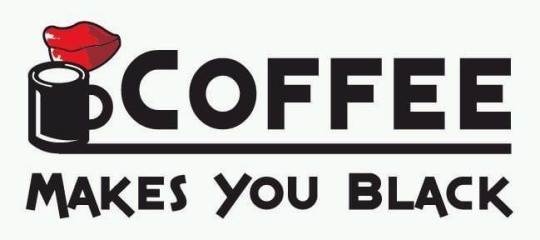

Support our local chapter!
If your organization or company is inspired by CreativeMornings/Milwaukee and wants to ensure that our events remain free & accessible to the Milwaukee creative community, become a Quarterly or 2024 Annual Partner! Contact us at [email protected].
*We are presently looking for breakfast and fiscal partners ;)Run by an engine of generosity.
Behind all the newsletters, social media posts, giveaways, speaker portraits, check-in tables, and flare is a talented team of volunteers. Do you want to write this newsletter? Interested in capturing our events with video? Let us know!
Big thank you to: Alea Cross, Alexa Seybold, Aly Miller, Annie Werner, Carley Knight, Caroline Ferrero, Hannah Rae Birkholz, Holly Schisler, Kaitlyn Johnson, Kelly Gehringer, Linda Smallpage, and Sarah Schauf.
0 notes
Text
My Journey in Alaska: Its Beauty and Natural, Breathtaking Landscapes
Clara S. Muchunguzi is a 2023 Fellow in the Professional Fellows Program on Inclusive Civic Engagement. This program is sponsored by the U.S. Department of State’s Bureau of Educational and Cultural Affairs and is administered by the Institute for Community Inclusion (ICI) at the University of Massachusetts Boston in partnership with Humanity and Inclusion (HI). The following blog post was written by guest author Clara S. Muchunguzi.
This long-awaited journey started on May 3, 2023 when I landed in Boston and received a warm welcome from Heike and Christa, our very own PFP team leads who have been very supportive and made sure this was a dream-come-true trip. May 4 was a brand-new day, and, despite the jetlag, I got an opportunity to wander around Boston. I visited the very old, legendary, and iconic university of ancient times — Harvard University, which is still rocking and a dreamed university of many, including myself. It was mesmerizing to learn the fairytale of John Harvard’s monument: that when you touch his foot, it brings good luck. I had to try mine. Who knows? I may get my PhD there, or my son, Jayden, may go to school there, so fingers crossed. It was so enticing, and I wish I had more days in Boston.
When I learned that I was going to Alaska, I had so many questions. I had barely heard of Alaska, and I had so many thoughts about what I would see there. Surprisingly, I had a wonderful four weeks of exploring, learning, and fantasizing in Anchorage, Alaska. Seeing the natural beauty of Alaska and its breathtaking landscapes brought some dazzling feelings. I am grateful for my host, Jessica Harvill, who welcomed me to her beautiful home and took me to view the beauty of the well-arranged Chugach Mountains of Alaska that were decorated with snow. I met noble people from the University of Alaska Center for Human Development and connected with brethren from different organizations. I learned their ways of life and the work they do in bringing meaning to life and to people that need special attention.

Clara (left) wood polishing materials to be used in artwork design at Hope Studio, an organization that works with people with disability.
Wildlife Encounter at the Alaska Zoo
I was mesmerized by the renowned, diverse wildlife I encountered at the Alaska Zoo, a lifesaving place for orphaned and injured wildlife animals with its own unique history. I had unforgettable moments at the zoo as I witnessed moose and the majestic moves of the giant bears in their different colors — black, brown, and white. I had such a pleasant feeling seeing the bald eagles — magnificent birds, well-known scavengers, and predators, crafted in unique color in their heads and tails — so admired for their beauty. The eagles are found in Alaska more than any other part of America and carry a spiritual symbol for the Alaskan natives that makes them very special.
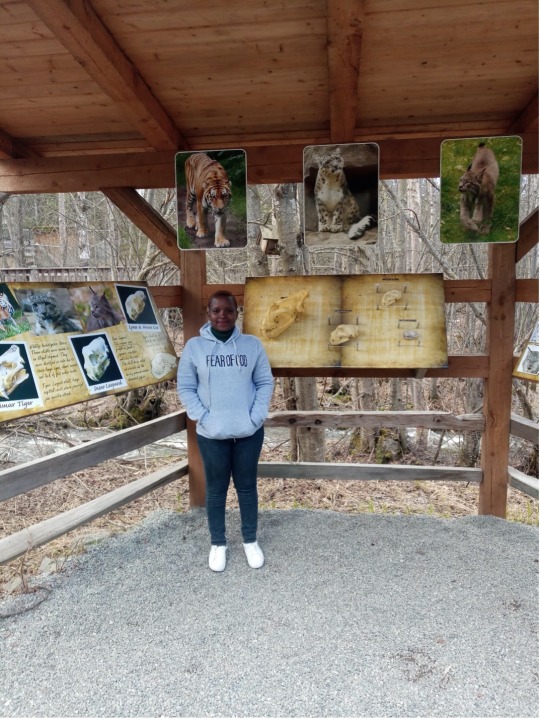
Clara stands outside the big cat exhibit at the Alaska Zoo
Cultural Immersion
I have learned many good things about the Alaskan indigenous heritage. I visited the Alaskan Native Heritage Center and learned about Alaskan cultures, architecture, traditional lands and languages, and creative arts, ranging from carving, basket weaving, and sewing to silver smiting. Amazing works represent Alaskan natives, including the underground houses they used to stay in and the equipment they used for hunting and fishing. I got to know the five native tribes: Athabascans, Inupiaqs, Yupiks, Aleuts, and the Northwest Coast Indians. I was so thrilled with my visit to Alaska, and I will definitely visit Alaska again and again.

Clara at the Alaskan Native Heritage Center, standing beside a totem for one of the Alaskan Native society
#professional fellows program#profellows#Institute for Community Inclusion#exchangeourworld#ExchangesMatter#citizen diplomacy#citizendiplomacy
0 notes
Text
Multimedia Blog 3 - taylorcassidyj
Taylor Cassidy (@taylorcassidyj on TikTok and Instagram) is a social media content creator and advocate with over 2 million followers on TikTok and over 200K on Instagram. Her content is centered around teaching Black history and spreading Black joy through engaging videos on TikTok, Instagram, and YouTube. She joined TikTok in 2019 where she began a series called “Fast Black History,” 1-minute videos about African American historical figures. Her following quickly grew amassing over 69 million likes on TikTok. Along with the “Fast Black History” series, she created the “Black Girl Magic Minute,” uplifting influential Black creatives. Cassidy has accomplished so much at the age of 20. She is from St. Louis, MO, where I am from! Growing up, we were in the Little Mermaid Musical together which inspired me to write about her. Cassidy is truly an influential figure of our generation and plans to take her advocacy on screen in films/TV.
In Cassidy’s “Black Girl Magic Minute” TikTok series, she celebrates Black creatives. Cassidy started this segment “to not only give credit back to these Black creators, but to uplift them and let people – even people who aren’t Black – discover new creatives and new, amazing people to follow and support” (Novato). In one discussion we focused on Judy Baca, a muralist who uses digital technology to create designs. She uses these designs to create murals in LA whose purpose goes beyond artistic value. They have social influence and are used as a political tool by representing most of the population who are usually voiceless. Cassidy and Baca are similar in giving a voice to the voiceless through different forms of media. Baca bases her art on people and uses digital technology to turn these ideas into reality, while Cassidy uses technology in a different form to convey her message. By uplifting Black creators, their platform can grow, and they can continue to grow doing what they love. Cassidy hopes to make “Black Girl Magic Minute” into a podcast to dive further into the subject.
As mentioned in our readings and discussions, the Harlem Renaissance was an influential moment in history for African Americans. The Harlem Renaissance was centered around Black pride, like Taylor Cassidy’s content. Post emancipation, many Black people in the south became sharecroppers and tenant farmers. In this position, they were in debt to white “landlords” and therefore in “economic bondage” despite being free (Takaki). Because of this, many Black people were eager to leave the south and find work up north. After a mass influx of Black people from the south, a sense of Black pride was formed in Harlem. Known as “the greatest Negro city in the world,” droves of Black people came from everywhere to experience the culture found in Harlem (Takaki). Black educational and economic success spread throughout the community. This is a typical topic Cassidy would create a “Fast Black History” video on. One of her TikTok videos mentions Glady Bentley, an American blues singer, pianist, and entertainer during the Harlem Renaissance. In the video, Cassidy dresses up as Bentley making it entertaining and educational. As mentioned in the video, “it was argued that [Bentley] was a drag king, but it was more that she dressed more masc to get jobs in Harlem night clubs during the Harlem Renaissance” (Taylor Cassidy). Bentley used her intersecting identities to her advantage so she could showcase her talents. The Harlem Renaissance was an opportunity for African Americans to express and create, similar to Cassidy’s social media content creation.
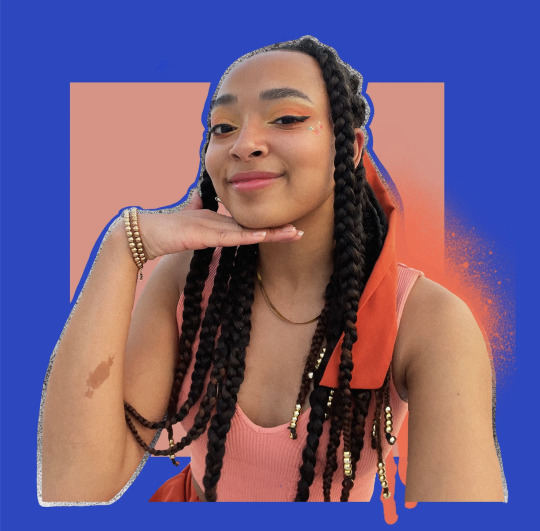
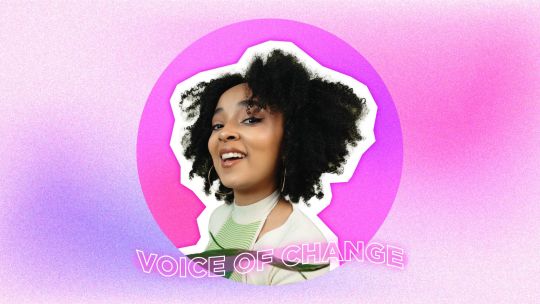
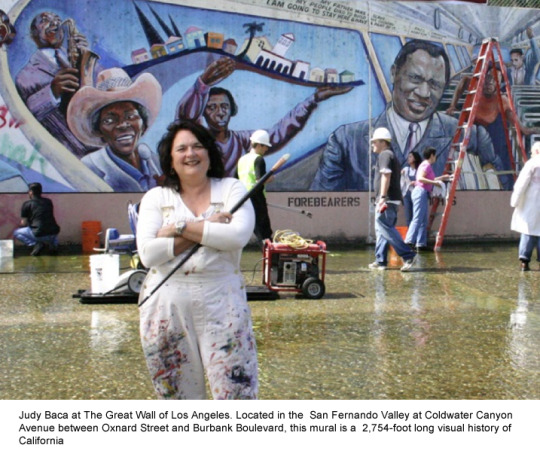
youtube
Works Cited
“Best of Fast Black History TikToks (Black Music, Pop Culture, and More!) | Taylor Cassidy.” YouTube, uploaded by Taylor Cassidy, 26 March 2021, https://youtu.be/1OZcOMwk5B0.
“Black Girl Magic Minute | Official Trailer | Taylor Cassidy.” YouTube, uploaded by Taylor Cassidy, 24 April 2021, https://youtube.com/shorts/YX9Vkp8dlh8?feature=share.
Campano, Leah. “Taylor Cassidy Makes Black History Accessible to Millions with a Viral TikTok Series.” Seventeen, 27 Feb. 2023, www.seventeen.com/life/a43050504/taylor-cassidy-voices-of-change/.
“Judy Baca.” California State University, Northridge, 15 Oct. 2015, www.csun.edu/mike-curb-arts-media-communication/judy-baca.
Novato, Olivia. “Taylor Cassidy: The Educator on Teaching Black History, 'Black Girl Magic Minute', and More.” Taylor Cassidy | The Educator on Teaching Black History, 'Black Girl Magic Minute', and More., flaunt.com/blog/taylor-cassidy.
Staff, Teen Vogue. “Teen Vogue's 21 Under 21 2021: The Young People Shaping Tomorrow.” Teen Vogue, Teen Vogue, 14 Dec. 2021, www.teenvogue.com/gallery/teen-vogues-21-under-21-2021.
Takaki, Ronald T., 1939-2009. A Different Mirror : a History of Multicultural America. Boston :Little, Brown & Co., 1993.
Taylor Cassidy [@taylorcassidyj]. “learn more about Gladys Bentley in my bio!” TikTok, 27 July 2022, https://www.tiktok.com/@taylorcassidyj/video/7125167391683743022?is_from_webapp=1&sender_device=pc&web_id=7156437192771192366.
@tamarakjohnston
0 notes
Text
apocalypse here
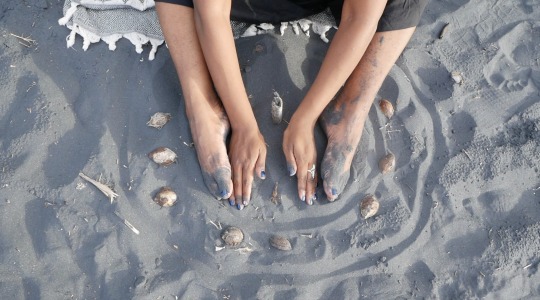
music by Stuff Studio
photography by Sharon Mansur
videography by Xitlali, Stuff Studio and Mai'a Williams
co-performers: Rowan Emmanuel and Xitlali
production manager: Brian Knouft
****
a multi-media installation/performance/shrine centered on their relationship to the Driftless natural landscape, the sacredness of Black and First Nations’ lives and histories in this region and globally, the healing traditions that they learned from their grandmother and elders in rural South Carolina.
This work explores questions such as: How do we exist in the face of uncertainty, conflict, trauma, and death? How do we find meaning in crises? How do we rest and celebrate? How do we talk to our ancestors and our children?
Mai’a Williams is a fiscal year 2022 recipient of a Creative Support for Individuals grant from the Minnesota State Arts Board. This activity is made possible by the voters of Minnesota through a grant from the Minnesota State Arts Board, thanks to a legislative appropriation from the arts and cultural heritage fund.
This activity is made possible through a grant from the Southeastern Minnesota Arts Council thanks to a legislative appropriation from the arts & cultural heritage fund.
****
Xitlali (she/they) is a Queer, reindigenized Mexican-American activist living in Baltimore, MD. She is working to strengthen Land and Food Sovereignty for Indigenous (Black and Brown) Peoples across the USA using finance as a tool. Raised in both the rural countryside of Mexico and the urban landcapes of the DC region, they have always walked between the boundaries of ancestral living and corporate america (believe me, it was a confusing childhood!). In addition to her professional work, they practice photography/videography to convey the beauty of Ancestrality, Creativity, and Resilience in a context of voracious Capitalist Empire that seeks to not only destroy our physical environment, but our possibility for a Future.
rowan (they / them) is an indigenous mixed, Xicanx/SWANA, queer, trans, non-binary, neurodivergent, disabled community herbalist & bodyworker, facilitator, mixed media art/puppet, full spectrum support companion and humxn dandelion puff. Their work focuses on transition, connection, laughter and liberation. When not working, they are off listening to and smiling with the elements and ancestors around us, growing food/medicine or chilling with their animal and humxn friends. Sometimes a mushroom or a beet, in rest + play.
StuffStudio (he&she) knows art is valuable and should always be accessible. Art is power, wisdom, and storytelling. Art has form, can be formless, is real and unreal, light hearted, heavy-hitting, soft spoken, delightful and enraged. Stuff is a human making art, making music, making movement and making experiences.
0 notes
Text
Getty Images (NYSE: GETY), a preeminent global visual content creator and marketplace, in collaboration with GLAAD, the world’s largest lesbian, gay, bisexual, transgender, and queer (LGBTQ) media advocacy organisation, has announced its latest global creative grant of US$25,000 focused on the Chosen Family. The grant seeks diverse perspectives, photographers and videographers to help increase visibility of the LGBTQ+ community while also challenging harmful, cliched visual stereotypes.
This grant will provide financial support and mentorship to content creators who are authentically showcasing and exploring celebrations, events and actions across a broad range of people and groups that are part of ‘chosen families’, outside of stereotypical Pride celebration imagery. This includes celebrations, new family norms and cultural traditions as they relate to LGBTQ+ communities around the world.
“Our VisualGPS global research shows that less than 1% of visuals in media and advertising show members of the LGBTQ+ community and those mainly focus on Pride celebrations as a defining event across the community,” said Dr. Rebecca Swift, Global Head of Creative Insights at Getty Images. “This grant aims to portray connections across the LGBTQ+ community, visualising people coming together to embrace, nurture, love, and support each other, irrespective of traditional familial ties.”
Recognising the challenges faced by photographers worldwide as they look to break into the commercial industry, the Getty Images’ creative grant consistently seeks to discover and nurture creative talent while also alleviating some of the financial hurdles they face to capture authentic content.
“Authentic and diverse media images of our community not only make LGBTQ people feel safe and seen, but educate the general public on the truth about our lives and the common ground we all share,” said GLAAD President and CEO Sarah Kate Ellis. “This grant will create more content that depicts the multi-dimensional and diverse nature of LGBTQ people, along with our immediate families and friends.”
Open to photographers and videographers globally, Chosen Family is a one-time grant, awarding one first-place recipient US$10,000, one second-place recipient US$7,000 and one third-place recipient US$3,000 each, as determined by an esteemed panel of creative industry judges and LGBTQ+ activists.
A special US$5,000 grant will also be awarded by the Getty Images’ employee resource group LGBTQIA+ Alliance.
Shortlisted projects will be judged by a panel that will include:
Monica Trasandes - Director of Spanish Language and Latinx Media & Representation at GLAAD; has created and overseen international campaigns and research projects around the world and authored her novel, “Broken Like This”.
Myles Loftin – Artist, storyteller, and creative collaborator working to increase visibility for underrepresented and misrepresented groups; Forbes 30 Under 30 in Art and Style.
Alex Schmider - Emmy®, Peabody, and Critics Choice Award nominated film producer and the Director of Transgender Representation at GLAAD.
Landyn Pan – Trans non-binary photographer and video producer with a mission to amplify the voices of queer and trans people of color through creating empowering and uplifting media.
LaQuann Dawson – Photographer, filmmaker, writer and visual director. His work explores themes of healing, isolation, desire, joy and disappointment while centering the visibility, wellness and liberation of Black and queer people.
Joon Park – Cultural strategist and founding member of GLAAD’s Campus Ambassador program. Is a recipient of GLAAD’s first Rising Stars Grant, which annually honors LGBTQ+ changemakers across the United States.
Abdool Corlette – GLAAD creative team lead; award-winning creative director & filmmaker with a focus on shifting culture through diverse, high-impact storytelling.
Thaddeus Coates – Artist creating bright and thought-provoking illustrations centered around amplifying Black voices alongside diverse representation, black queer joy and other topics.
Content creators are encouraged to apply before November 18, 2022, at which point the application period will close. Recipients of the Creative Grant will be announced during the week of December 12th.
To apply, photographers and videographers must submit the following:
Links to existing portfolio of work online
The submission must include: a 200-500-word summary of the project proposal and an inspirational mood board
A short essay that outlines the approach
Proposals must be in English
Submissions must be digital
Grant recipients are invited to license their award-winning content through GettyImages.com, at a 100% royalty rate for imagery created within their proposed project. Entrants will also receive guidance and mentorship from one of Getty Images’ award-winning Art Directors, as well as a feature on Getty Images’ Creative Insights website, in addition to promotion across relevant social channels. Please note, this additional support is not a requirement of the creative grant and is at the discretion of each recipient.
The Getty Images Creative Grants are a core piece of the wider Getty Images Grants program, collectively aimed at supporting the world’s photographic and photojournalism community. Since the inception of the program in 2004, the company has awarded in excess of US$2.4 million, furthering our commitment to the craft of photography and bringing attention to important stories that without funding, may otherwise remain unseen. Further details on the Getty Images grants program available here: https://grants.gettyimages.com/.
To apply: https://grants.gettyimages.com/chosen-family
0 notes
Text
Creating ethical research Who is designing the research? You and your supervisors and co researchers Charles Grinter ethics adviser What is ethics? What should we do? Why do we need to think about what we should do when we are creating research? Research we are guests in the private spaces of the world. How we get there determines how we arrive. The problem question of ethics, how do we decide what is ethical in a society in which there are competing system of values? www.aut.ac.nz/ It goal needs to be ethical How you go about is needs to be ethical And both of these needs to appear to be ethical. Fabrica Designing with/for people Human center design – improving the life's of people Design for people; approach/flied Inclusive design Accessible design Universal design Designing with people; methods and models Collaborative design Partctiory design Inclusive design- advocate for the design of everyone's social issues Designing for as many people as possible Accessible design Is a design process is which is needs of people with disabilities are specifically considered Grad 604 lecture one Make sure to get the app and linece again. We 533 12pm-2pm In the tumblr 604/602 THREE PARTS OF THIS DESIGN RESEARCH. Formative On screen presentation of progress work work. Steps towards. Visual and written components Summative Type written and visual to communtate design research journal Title subtitle abscrat and self generated new typograpghic deign visua work produce a full page image Type written in jouenal contuations Postioning reasearch and review knowledge,, the design / art work of other apprisal of context and any supporting research litature reiw Will producea a2 poster either replication or a bit of it Typograpgy selecting type face but get good look and apprecting the origns intentions and uses. Contemporty or historic Hevatic - futurist typography – pual scher – steps in the process –sketch book stage – visual dective work – be motivated- be curious – look at second hand book or ops hopes inspiring old publications Be tatctial Be informing WEEK 2 Reimaging letters press types (black letter) Confusion, confidence, curiosity, connections UPLOAD THINGS IN TUMBLR DORK Confined: What do you know? Think about conversational and uploading Confidence: what do you make? What are your emerging communication design skills? Or what kind of work do you want to make? Think about your design approach What specific aspects styles or processes of communication design to inspire or interest you? Who are your favorite designers and creatives What is it about their work that inspires you? What context does their work respond to or explore? Areas of design practice that are of interest to you might be technical. Kiln tyep foundary Or themic – i.e., music or political posters from the 1960s Lot of looking and integrating the source that you look at Historical Designs. Eg book design, If you have a favorite illustration style, find work, and use it? Formatted (form) illustrations style Or you can find design work that is conceptually related to your interests. This might be place people objects or reactions What are your curios to use your emerging skill to respond to or explore? Connections Teams for research are now up. Teams are just a thing, blogs are heavy lifting Excel sheet, find name start thinking about dome of the stuff you are into, places to find stuff, eye magazine. DESIGN RESEARCH WRITING Check out the formative slide guide 3 books 3 drop mark web-based resources- do the word pages Building research, reading more, writing more Evidence connection Write a research question, title, theme or sentence which conveys your line of enquire om terms of your practice. Making connections What is your reasearch area What is your postion? Intersectionality, analitic framework for understanding Person social, Political CRITIAL ALPHABET Eye on design Essay research needs to have an unpinning of 90% of material that is never seen but allows the 10% visible to be carefully chosen. Make small easily achievable goals and meet them When stuck keep writing Avoid virtuous procrastination Write daily Be clear, coherent, concise Use short or mixed length sentences Avoid the passive voice (you voice) Commnication- respect for the read Craft- respect for your tools (here language) Creativity- respect for the endeavor (process) Concrete ideas over abstract ones Express complex ideas clearly Have carefully crafted elegant sentences A sense of energy Display intellectual commitment/ passion Tell a compelling story Avoid jargon unless necessary Write with originality, imagination flair Glossier of term maybe? If super techinqual Write in your voice Interesting titles and subtitles Fits person anecdotes (stories) Catchy opening paragraphs Avoid too much abstract language and used energetic verbs Good choice of illustrations Drew on a broad range of sources Used humor According to steven pinker, the curse of having knowledge is increaingly not knowing what your audince can be expected to know Se selecting materail and structure writings is about curating the read experinces. Concret examples give colour tp your writing and help connect ypo to your read experince Absract ideas find the connections threads in semmingly different pieces of edvidence. Code a text from your reasearch, by key words Thing of your key words being where you identify ;links in the texts you read You have identified significat pieces of evidence and found themes Can you connect them Modeller or craver? Are you thinking of writing as coming up with an idea and then writing it Writing is not copying an idea in your head the idea is created through writing You cannot fully know your ideas until you start writing them Unerstanding teh question or asking your own question What foemat of writing is approtie s Define a problem, process or effect Analyase it to define a the compatent parts/ themes Explain what makes each of these significany Conclude Define Define and defend a position Identify and access the evidence Build a reasined case selecting examples that support you rcase Conclude by reiterating your postion in the light of the evidence Dicuss Look at all sides of an issure Use introdction to locate subject/issue Identify a rage of appriches The writer diet
1 note
·
View note
Text
Jeff Fard | Multimedia Journalist

Join My Black City in Celebrating and Supporting Jeff Fard | Multimedia Journalist. We Shine Brighter Together. #MyBlackCity
https://myblackcity.org/jeff-fard-multimedia-journalist/?feed_id=15392
>> Jeff S. Fard, Colorado native, known as Brother Jeff, is a multimedia journalist, historian, and community organizer. Fard is a national speaker to youth, students, social organizations, and professionals. There are a vast amount of topics Fard speaks on like cultural identity and history, diversity, self-empowerment, community building, economic development, health disparities, and the uniting power or art. Brother Jeff’s Cultural Center, founded in 1994, is located in the historic Five Points District of Northeast Denver. It was a space established for nurturing growth, strength, and develop the voice of the community. Brother Jeff is also a publisher and editor of the award-winning monthly publication 5 Points News.
>> What do you do?
I am a multimedia journalist. I use print media, radio, and various social media platforms to help make [the Black] community and the broader community more aware of all of the different aspects of Black culture throughout Colorado.
Why do you think using social media to raise awareness has been effective for you?
I use social media very strategically. I understand that throughout time people have communicated and disseminated information. The only different thing is the medium. A lot of individuals don't understand the tenants of media and how it works. Those who are successful are just like any other professional. They study the trends, and they learn the pros and cons. They also target their audiences and understand analytics. Most people see the end result, but they rarely see what's under the hood. It takes work to make anything successful, that is true of media as well. Most folks think it's easy just to go ahead and point a camera at themselves and hit play, but effective communication is an art, a skill. Creating compelling content takes work. When those at the highest level do it well, it looks deceptively simple. Knowing the fundamentals allows you to be more creative and flexible to improvise, just like a seasoned musician.
What advice would you give to people who are trying to follow your footsteps?
I would encourage anybody who wants to succeed in any field, to look at those who are at the top of that game. Then, study the principles and the work ethic that they employ. And then I would say ask questions. I've never really been denied access to anybody when I'm seeking assistance, advice, or information. Today it's easier because you can inbox practically anybody on social media. When you make contact with an individual, be clear about what you are seeking from them because everybody has limited time.
The most successful people are the ones that will come to any professional and say how do you do XY and Z and what can I do to become more successful, and that puts the person you're asking in a humble position. It also puts them in a position to be studious, and now you're having a valuable exchange of someone's time. Lots of people pay a lot of money to learn these lessons, but if you can just humble yourself and ask someone the right questions, You can save yourself a lot of time and money in today's world.
How important is it to you to have a good team around you?
The team concept is integral to what I do. Technology allows you to do a lot with a little. We have minimal equipment and minimal space, but I have reliable people that I have been working with for years. We're all on the same page in terms of being able to adapt quickly to whatever we're doing. Nowadays, what it used to take 100 people to accomplish, you can do with ten reliable people. You've got to have visionary people, you've got to have people who are skilled at their position.
How long did it take to develop these partnerships you have?
People would be surprised at how many contacts I have just in my cell phone and the relationships I have.
So the question is, how do you develop it? Over time you build your relationships one at a time. You do this by finding ways to make your connections personal and meaningful.
I've always been interested in things that work, and curious people are the ones that tend to create great things. I've been around a lot of people, and I can whittle down certain principles that I would say are universal to success:
Be curious. It's how you get creative and very skilled at your position.
Show me somebody that's up working when everybody's asleep, and I'm going to show you somebody that's going to be successful.
0 notes
Text

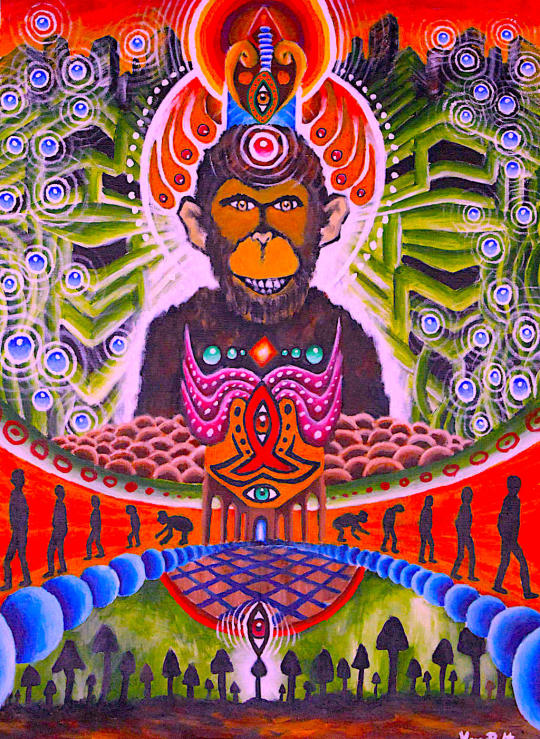

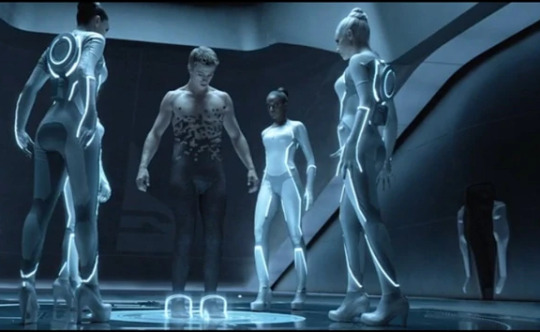
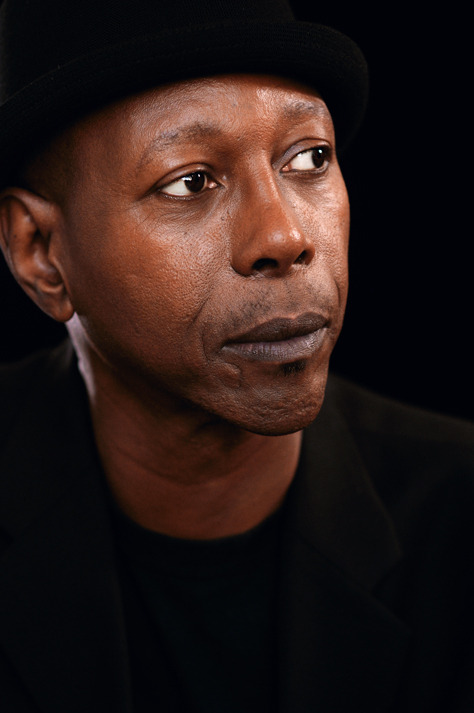


ALBUM OF THE WEEK! peter chauncey EVOLUTION RECONFIGURED https://peterchauncey1.bandcamp.com Creating music that evolves somewhere between electronica, art rock, and Americana, singer-songwriter peter chauncey recently released this online album—a collection of songs that have drawn comparisons to Seal and David Bowie. The album includes his originals plus remarkable covers of songs by Bowie, Fleetwood Mac, and The Yardbirds. Support musicians include Daniel Berkman, DJ Luxxury, Will Mandell, and Johnny J. Blair (who also produced several cuts).
Peter wrote, “There are many ways to look at or analyze any given song, through all sorts of lenses or filters, through combinations of political, religious, environmental, cultural, or social experiences that are bound to change each of us over time.”Currently based in the San Francisco Bay Area, peter originates from Jackson, Mississippi, a ciry with a locus of experiences that echo in peter’s songs. “Jackson was, and continues to be, on the forefront for civil rights, not just for black people in the United States but, by extension, human rights and equal opportunities for all peoples. Many, many people died to make way for the changes that all of us are benefitting from to this day,” notes peter. As a creative center, Jackson birthed electronic music composer Milton Babbitt, as well as many blues and jazz artists, like Otis Spann and Cassandra Wilson. Jackson is also called The City of Soul, referenced in films and literature, not to mention a Johnny Cash song. All these elements inform peter’s music.
“I've always been chasing after that feeling that you get when you hear a song--and it really affects how you feel in that moment--so much so that you really have to stop to re-group or re-assess in order to decide if you are going to back to what you were doing. Sometimes, there is no going back.” Listen here: https://peterchauncey1.bandcamp.com
#peterchauncey #peterchatman #davidbowie #seal #fleetwoodmac #danielberkman #johnnyjblair #jackson #mississippi #sanfrancisco
#Peter Chauncey#Peter chatman#David Bowie#Seal#johnny j blair#singer songwriter#music#san francisco#pop rock#david bowie#Fleetwood Mac#Daniel Berkman#Jackson#Mississippi#San Francisco
1 note
·
View note
Text
In this visionary Ndebele world, the abolition of transphobia and transmisogyny would be a collective effort, driven by a culture of empathy, understanding, and celebration of diversity. Here are some key ways in which transphobia and transmisogyny would be abolished and prevented:
Education and Awareness: Comprehensive education about gender diversity, transgender experiences, and the harmful effects of transphobia and transmisogyny would be integrated into the curriculum from a young age. Schools and educational institutions would prioritize creating safe and inclusive spaces, where all students are taught to respect and appreciate different gender identities.
Media Representation: The media would play a pivotal role in normalizing and celebrating black trans people. Positive and diverse representations of transgender individuals in movies, TV shows, advertisements, and other forms of media would help challenge stereotypes and promote understanding. Media outlets would actively seek out and amplify the voices and stories of black trans people to foster broader acceptance and recognition.
Advocacy and Allyship: Robust advocacy efforts and allyship would be at the forefront of societal change. People from all walks of life would come together to support the rights and dignity of black trans individuals. Advocacy organizations, led by both cisgender and transgender individuals, would work tirelessly to dismantle discriminatory laws, policies, and practices.
Inclusive Healthcare: Accessible and inclusive healthcare services would be available to all individuals, regardless of their gender identity. Medical professionals would receive specialized training to provide affirming and respectful care for black trans people. This would contribute to the overall physical and mental well-being of the community.
Legal Protections: Comprehensive legal protections would be put in place to safeguard the rights and safety of black trans individuals. Laws against discrimination, hate crimes, and violence based on gender identity would be strictly enforced. Legal reforms would ensure that transgender people can live openly and authentically without fear of persecution.
Community Support: Strong community support networks would be established to provide a safe and nurturing environment for black trans individuals. Community centers, support groups, and cultural events would celebrate transgender identities, fostering a sense of belonging and pride.
Leadership and Representation: Black trans individuals would hold positions of leadership and influence in various sectors, including politics, business, arts, and academia. Their representation in decision-making processes would ensure that policies and initiatives are inclusive and responsive to their needs.
Challenging Harmful Traditions: Any harmful cultural practices that discriminate against transgender individuals would be openly discussed and challenged. Community leaders and elders would actively participate in these conversations, working together to reshape cultural norms and attitudes.
Intersectionality and Solidarity: Intersectionality would be a cornerstone of the society, recognizing the interconnectedness of identities and experiences. Solidarity among different marginalized groups would strengthen the fight against discrimination and oppression.
Empowerment through Art and Expression: Artistic expression, including visual arts, music, literature, and performance, would be embraced as a means of empowerment for black trans individuals. Their creativity and talent would be celebrated, inspiring others to embrace their true selves.
By combining these efforts, the Ndebele society would create an inclusive and compassionate environment where transphobia and transmisogyny have no place. The normalization and celebration of black trans people would be deeply ingrained in the culture, contributing to a society that celebrates diversity, fosters empathy, and ensures the full flourishing of every individual, regardless of their gender identity.
0 notes